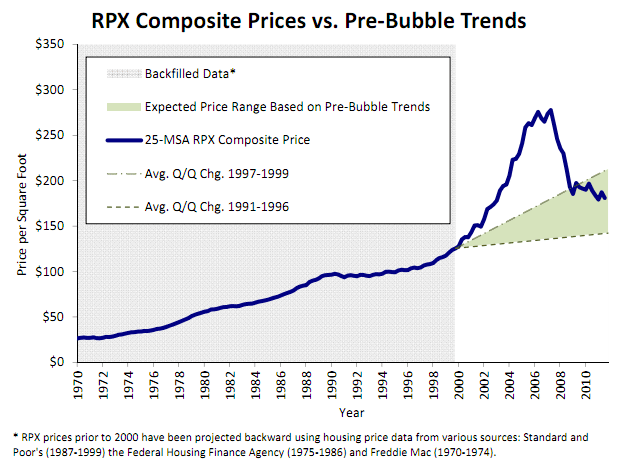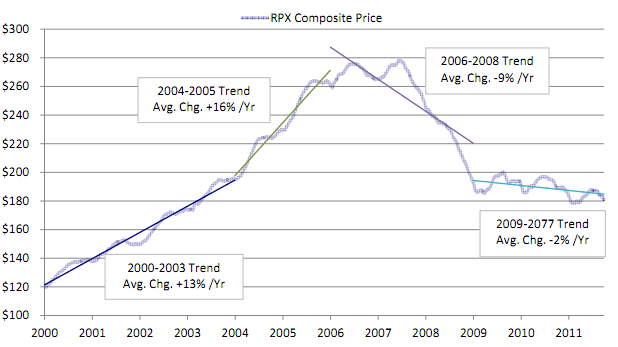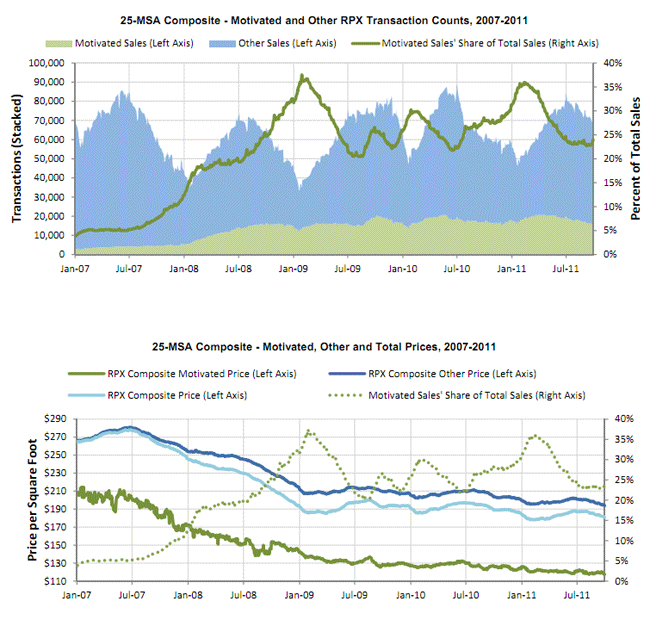The Chicago Board Options Exchange (CBOE) will soon permit futures trading in housing through a derivative based on the Radar Logic Composite Price. According to information released by Radar Logic, a New York City real estate data and analytics company, this derivative will allow institutions both to hedge against downturns in housing prices and to allocate portions of their investment portfolios to housing assets without the search, transaction, and maintenance costs association with purchasing physical properties. Or, as the background information the company released today says, "RPX futures will allow you to invest in residential real estate without having to mow the lawn."
It is not our purpose to assist Radar Logic in its promotional campaign nor is this intended as a discussion of the appropriateness of encouraging further speculation in the housing market although that discussion could be a worthy one. However, the "RPX Housing Market Review" released by the company last week does explain the methodology underlying calculation of the Radar Logic Composite Price and provides a context for anyone who is interested in following this new market.
This is not the first such venture into housing derivatives. In the fall of 2007, Radar Logic helped launch a market for a privately traded product which reached $4 billion in 14 months. The subsequent housing bust demonstrated that values can decline nationwide in unison and presenting investors with additional motivation to hedge against downturns in values.
Home prices are now in a range that would have been expected absent the boom and bust of the last decade. As a test of its model, the RPX figures which date back to 2000 have been augmented with housing data from S&P, the Federal Housing Finance Agency, and Freddie Mac. From 1991 through 1996 housing was in the worst slump in 20 years and price increases were at a very slow pace. During this period RPX Composite prices increased just $0.35 per quarter compared to the average of $.83 from 1970 to 1999. This rate was used to calculate the pessimistic scenario for home prices over the 2000 to 2011 period. For the optimistic scenario the designers used the average quarter-over-quarter growth rate from 1997 through 1999 when the tech bubble ended the stagnation of the preceding six years and the Composite grew at an average quarterly rate of $1.82.
Using the pessimistic scenario to project growth over the 11 year period since 2000 would have resulted in a composite of $142 per square foot (psf) as of September 30, 2011, 27 percent lower than the actual value. Using the optimistic scenario, the projection would have been $213 psf, 18 percent above actual value. "Back in early 2000," the review says, "most housing market observers would have expected housing values to grow at somewhere between the rates in these scenarios. Home values, as measured by the RPX Composite price, are now within this range."

As of January 31, 2000, the 28‐day RPX Composite price was $121.96 per square foot. By December 31, 2005, it had increased to $261.21 per square foot, reflecting a 13 percent average annual growth rate from 2000 through 2003 and a 16 percent average annual growth rate from 2004 through 2005 (Figure 2). The 28‐day RPX Composite price peaked at $278.32 on June 8, 2007, 109% greater than its value seven years prior. In other words, housing values doubled in less than seven years.
This growth resulted from several factors. An extended period of very low interest rates was instituted by the Federal Reserve to spur the economy after the 2011 recession. This was bad for fixed-income investors and they went searching for new investments with higher returns, overwhelmingly choosing U.S. mortgage debt through mortgage backed securities. This sparked the pursuit of more and more loans, leading to lower mortgage standards, increased demand for housing purchases and rising prices. This then led to riskier loans, increased defaults, a glut of foreclosures, falling prices, etc.

Sales at auctions and through lenders,
i.e. "motivated sales" resulted in substantial price discounts and rapid
falling of the RPX Composite price in 2007 and 2008 and these sales still
remain a significant percentage of sales, seasonally ranging between 20 and 38
percent.

According to Radar Logic, home prices have fallen back to about where we would expect them to be given pre‐bubble growth rates.
- Home prices have dropped to the point where some institutional investors see portfolios of distressed properties as attractive investments. Demand from such investors has helped stabilize home prices.
- Inventories are slowly decreasing, including distressed inventories in non‐judicial foreclosure states and new home construction is down.
- Housing is now cheap relative to other tradable asset classes. In historical perspective, housing is cheaper than gold, which is just slightly off its all‐time high. Housing is also cheap relative to bonds, as bond prices have been driven upward by the impact of public policy.
The company feels "as the largest asset class there is, housing represents an investment for which everyone should consider an allocation." We leave that decision to you.







